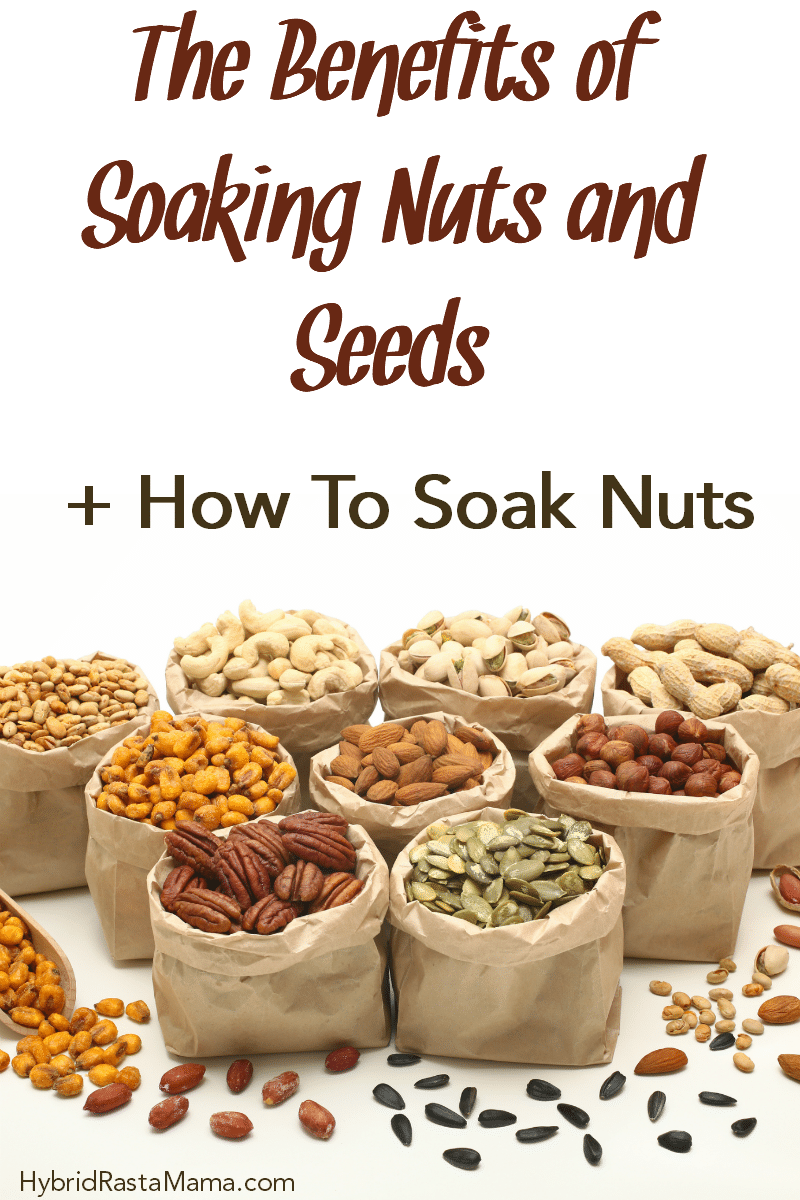Nuts come in all shapes, sizes, textures, and colors. There are big nuts, small nuts, round nuts, oval nuts, oddly shaped nuts, hard nuts, soft nuts, nuts with bumps, smooth nuts, dark nuts, light nuts, spotted nuts, nuts with ridges, and nuts with wrinkles.
Nuts really vary in taste as well as texture. Raw nuts allow you to experience their flavor as nature intended. However, not everyone likes the taste of nuts in the purest form. For those individuals there are crispy nuts, salty nuts, sweet nuts, candied nuts, spiced nuts, creamed nuts, roasted nuts, boiled nuts, dry nuts, and wet nuts.
Wet nuts? Oh yes. Anyone who consumes any nut (or seed or grain for that matter) should be soaking your nuts for 24 hours before consumption or before using them in cooking and baking.
Whew – this is a lot of talk about nuts! Shall we chat about the benefits of soaking nuts as seeds as well as how to soak nuts? Cool. Let start with the basics…
The Benefits of Soaking Nuts and Seeds
Soaking nuts and seeds is a long-lost, traditional method of preparation. When nuts and seeds are soaked, the germination process begins, in which the active and readily available amounts of enzymes, vitamins, minerals, proteins and essential fatty acids begin to be activated and multiplies exponentially.
However, nuts and seeds also contain phytic acid and large amounts of enzyme inhibitors which protect them from sprouting until they have the rain and sun they need to grow. The enzymes inhibitors will limit digestion and it will significantly reduce the nutrition of the nuts and seeds. These natural chemicals are quite hard on the stomach so soaking also makes them much easier to digest and the nutrients more easily absorbed by your body.
Soaking and sprouting your nuts and seeds increases their vital minerals and nutrition, while also simultaneously allowing the inhibitor enzymes to shed off the nuts and into the water (that’s why it is important to rinse them off well), making them easier for your body to assimilate and digest out of the body.
Are those crickets I hear? Still a little confused? Ok, here is a bullet list outlining reasons why you should soak your nuts and seeds!
- To remove or reduce phytic acid.
- To remove or reduce tannins.
- To neutralize the enzyme inhibitors.
- To encourage the production of beneficial enzymes.
- To increase the amounts of vitamins, especially B vitamins.
- To make digestion easier.
- To make the proteins more readily available for absorption.
- To prevent mineral deficiencies and bone loss.
- To help neutralize toxins in the colon and keep the colon clean.
- To prevent many health diseases and conditions.
There is a lot of information about the recommended soaking times for nuts and seeds. Below you will find the MINIMUM soaking times for a variety of nuts and seeds. 12 hours/overnight is best, but if you are in a rush, please follow these guidelines. Make sure all nuts and seeds are raw before you begin.
- Almonds: 8-12 hours
- Cashews: 2 hours. Cashews are the exception to long soaking time. Do not soak them more than 7 hours. They have already been through one soaking in their initial processing. If they are soaked too long they will be bitter.
- Hazelnuts: 6-8 hours
- Macadamia Nuts: 2-4 hours. There is a lot of mixed information on this one. Some say soak, others say don’t. I err on the side of caution and soak them.
- Pecans: 6-8 hours
- Pine Nuts: 6-8 hours
- Pumpkin Seeds (aka Pepitas): 6-8 hours
- Sesame Seeds: 4-6 hours although if you toast them, some people believe you can skip the soaking step.
- Sunflower Seeds: 6-8 hours
- Walnuts: 6-8 hours
Do not soak Flax Seeds/Chia Seeds (they become mucilaginous when mixed with water, but this makes them a nice egg replacer for dairy-free baking), Hulled Hemp Seeds, Brazil Nuts, and Pistachio Nuts.
Wondering how to soak nuts and seeds? Here is an easy guide:
- Place 4 cups of raw nuts or seeds in a glass bowl.
- Sprinkle 1 tablespoon of ocean sea salt over them (if soaking less than 4 cups less salt is added accordingly). No acid medium is necessary for soaking nuts and seeds.
- Pour enough warm/room temperature non-chlorinated water over them, just enough to cover them.
- Leave them to soak in a warm place.
- Drain off the water (do not rinse them), and pat them dry with a towel.
You can eat the nuts freshly soaked if you like your nuts on the soft side. If you are going to use them in a protein shake or bake with them, you may use them as is. If you wish to have them crunchy again, the best way to achieve this is to use a dehydrator.
Seeds are air-dried at room temperature, and nuts can be air-dried too, or they can be dried in a dehydrator or the oven. If using a dehydrator, follow the manufacturer’s instructions. If dehydrating in an oven, here is the basic method:
Spread nuts out on a cookie sheet and dry them in the oven on the lowest heat possible for 12-24 hours depending upon the type of nut/seed – the temperature should not go above 150°F since it can burn them.
Some nuts, like pecans, only require the oven light to provide enough heat to dry them without burning them – they shouldn’t be left in the oven for more than 4 hours, and then they should be air-dried the rest of the way. Some ovens will require the oven door be propped open with rolled towels to keep the heat in and the light on at the same time.
It is better to be cautious when drying nuts in the oven, even when only using the oven light, because they can burn very easily. They can also be dried at room temperature but it will take longer.
Ensure the nuts and seeds are totally dried before storing them or they will have more of a tendency to mold. If you aren’t sure they are completely dried, put a paper towel in the jar, with the lid on tight, for 24 hours to soak up the moisture, and then refrigerate them. Store nuts and seeds in glass containers with tight fitting lids, and keep them in the refrigerator.
What is your favorite nut but more importantly, are you soaking it?









Anonymous says
Lol oh yes I’d put them right in my mouth haha.